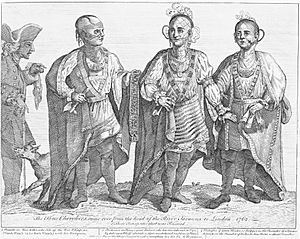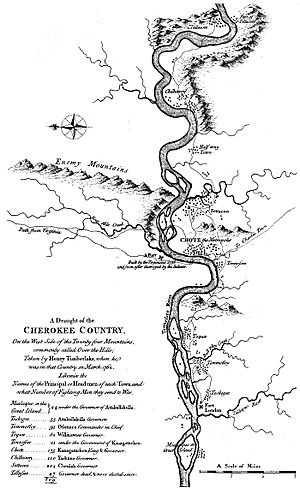Anglo-Cherokee War facts for kids
Quick facts for kids Anglo-Cherokee War |
|||||||
|---|---|---|---|---|---|---|---|
| Part of the Seven Years' War | |||||||
 After the Anglo-Cherokee War, bitterness remained between the two groups. In 1762, Henry Timberlake took three of the former Cherokee adversaries to London to help cement the newly declared friendship |
|||||||
|
|||||||
| Belligerents | |||||||
| Cherokee | |||||||
| Commanders and leaders | |||||||
| Attakullakulla Oconostota |
William Henry Lyttelton Archibald Montgomerie James Grant |
||||||
The Anglo-Cherokee War was a conflict between British forces and the Cherokee people in North America. It happened from 1758 to 1761. The Cherokee called it the "war with those in the red coats." This war took place during the larger French and Indian War.
At first, the British and Cherokee were allies. But both sides started to distrust each other. British settlers were moving onto Cherokee lands. This caused more and more tension during the 1750s. Finally, open fighting began in 1758.
Contents
Why the War Started
The Cherokee had been allies with the British for a long time. They even helped the British in earlier wars. For example, they fought alongside the British in the Tuscarora War (1711–1715). They also helped defeat the Yamasee people in 1715.
When the French and Indian War began in 1754, Cherokee warriors helped the British. They fought against the French at Fort Duquesne (now Pittsburgh, Pennsylvania). They also fought against the Shawnee people.
However, some Cherokee leaders were friendly with the French. French agents often visited Cherokee towns. Leaders like Conocotocko ("Old Hop") were very pro-French. His nephew, Conockotocko ("Standing Turkey"), also favored the French.
In 1758, the Anglo-Cherokee War officially began. Virginia militia attacked a Cherokee leader named Moytoy of Citico. They accused the Cherokee of stealing horses. Moytoy then led attacks on colonial towns in North Carolina. This started a cycle of revenge.
Key Events of the War
The British and Cherokee built forts in each other's territories. The British built Fort Prince George near Keowee in South Carolina. They also built Fort Loudoun near Chota in 1756.
In 1758, the Cherokee helped the British capture Fort Duquesne. But they felt their efforts were not appreciated. On their way home, some Cherokee warriors were killed by Virginians. The Cherokee believed they were owed supplies. When they took some horses, the Virginians killed 30 to 40 warriors.
Hostages and Attacks
Some Cherokee leaders wanted peace. But others led attacks on British settlements. In 1759, the Cherokee officially declared war.
The governor of South Carolina, William Henry Lyttelton, stopped all gunpowder shipments to the Cherokee. He gathered an army of 1,100 men. The Cherokee needed gunpowder for hunting. So, they sent 29 chiefs to negotiate peace. But Governor Lyttelton took them prisoner as hostages. He sent them to Fort Prince George.
Governor Lyttelton thought this would bring peace. But the Cherokee were still angry. They kept attacking frontier settlements in 1760. In February 1760, they attacked Fort Prince George to free their hostages. The fort's commander was killed. His replacement then killed all the Cherokee hostages. The Cherokee also attacked Fort Ninety Six, but it held strong.
The Cherokee expanded their attacks into North Carolina. They even reached areas near modern-day Winston-Salem. An attack on Fort Dobbs was stopped by General Hugh Waddell. However, many smaller settlements fell to Cherokee raids.
British Counterattacks
Governor Lyttelton asked for help from Jeffery Amherst. He was the British commander in North America. Amherst sent Archibald Montgomerie with 1,200 troops. Montgomerie's army destroyed some Cherokee towns, including Keowee. But he was defeated at Echoee Pass. Later in 1760, the Cherokee captured Fort Loudoun.
In 1761, James Grant replaced Montgomerie. Grant led a large army of 2,600 men. This was the biggest force to enter the southern Appalachians at that time. His army moved through Cherokee lands. They defeated the Cherokee at Echoee Pass again. They then destroyed about 15 Middle Towns. They also burned many fields of crops.
Peace Treaties and Aftermath
In November 1761, the Cherokee signed a peace treaty with the Colony of Virginia. They made peace with South Carolina the next year. This was called the Treaty of Charlestown.
During the Timberlake Expedition, Lieutenant Henry Timberlake traveled to the Cherokee lands. He delivered a copy of the treaty with Virginia. Timberlake's diary and map were published in 1765. His diary gave a good description of Cherokee culture.
The pro-French leader, Standing Turkey, was replaced. Attakullakulla, who favored the British, became the new "First Beloved Man." John Stuart became the British Superintendent of Indian Affairs for the Southern District. He was the main link between the Cherokee and the British government.
Many Cherokee towns were destroyed during the war. Some were never rebuilt. The war greatly reduced the number of Cherokee warriors. Before the war, there were about 2,590 warriors. After the war, due to fighting, disease, and hunger, there were only about 2,300.
After the war, French Louisiana east of the Mississippi went to the British. Spanish Florida also went to Britain.
Cherokee Visit to London
After the treaties were signed, Henry Timberlake visited London. He brought three Cherokee leaders with him: Ostenaco, Standing Turkey, and Wood Pigeon. The Cherokee guests visited the Tower of London. They met famous people and drew huge crowds. They even met King George III. Their interpreter died on the way to England, which made communication very hard.
The colonists in South Carolina saw the Cherokees' warm welcome in London as unfair. They felt the British government favored the Cherokee over them. This feeling grew stronger with the Royal Proclamation of 1763. This rule stopped settlers from moving west of the Appalachian Mountains. These issues were some of the reasons that led to the American Revolution.
Images for kids
-
After the Anglo-Cherokee War, bitterness remained between the two groups. In 1762, Henry Timberlake took three of the former Cherokee adversaries to London to help cement the newly declared friendship




